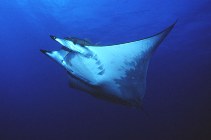| Family: |
Mobulidae (Devilrays) |
| Max. size: |
520 cm WD (male/unsexed); max.weight: 1,500 kg |
| Environment: |
pelagic-neritic; marine; depth range 0 - 700 m, oceanodromous |
| Distribution: |
Probably circumglobal in warm seas. |
| Diagnosis: |
Larger than M. hypostoma, tail with spine and prickles (Ref. 6902). |
| Biology: |
An epipelagic species (Ref. 6808) found over continental shelves and near oceanic islands (Ref. 6679). Feeds on small pelagic fishes and crustaceans (Ref. 6679), by funnelling using their cephalic fins and then trapping or filtering the food through their specialised gill plates (Ref. 115943). Ovoviviparous (Ref. 50449). Bycatch mortalities have been reported from Mediterranean fisheries - large-scale driftnets, purse seines and trawls, bottom set nets, trammel nets, longlines and even fixed traps for tuna. It is utilized for its meat as protein source (except the head) and gill plates as ingredient in Chinese medicine (Ref. 115943) |
| IUCN Red List Status: |
Endangered (EN); Date assessed: 20 November 2018 (A2bd+3d) Ref. (130435)
|
| Threat to humans: |
harmless |
Source and more info: www.fishbase.org. For personal, classroom, and other internal use only. Not for publication.

